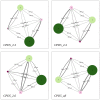Understanding Passive Membrane Permeation of Peptides: Physical Models and Sampling Methods Compared
- PMID: 36902455
- PMCID: PMC10003141
- DOI: 10.3390/ijms24055021
Understanding Passive Membrane Permeation of Peptides: Physical Models and Sampling Methods Compared
Abstract
The early characterization of drug membrane permeability is an important step in pharmaceutical developments to limit possible late failures in preclinical studies. This is particularly crucial for therapeutic peptides whose size generally prevents them from passively entering cells. However, a sequence-structure-dynamics-permeability relationship for peptides still needs further insight to help efficient therapeutic peptide design. In this perspective, we conducted here a computational study for estimating the permeability coefficient of a benchmark peptide by considering and comparing two different physical models: on the one hand, the inhomogeneous solubility-diffusion model, which requires umbrella-sampling simulations, and on the other hand, a chemical kinetics model which necessitates multiple unconstrained simulations. Notably, we assessed the accuracy of the two approaches in relation to their computational cost.
Keywords: Markov State Model; free energy profile; molecular dynamics simulation; peptide membrane permeability; umbrella sampling.
Conflict of interest statement
The authors declare no conflict of interest regarding the publication of this article.
Figures






References
-
- Vergalli J., Bodrenko I.V., Masi M., Moynié L., Acosta-Gutiérrez S., Naismith J.H., Davin-Regli A., Ceccarelli M., van den Berg B., Winterhalter M., et al. Porins and small-molecule translocation across the outer membrane of Gram-negative bacteria. Nat. Rev. Microbiol. 2020;18:164–176. doi: 10.1038/s41579-019-0294-2. - DOI - PubMed
-
- Moynié L., Milenkovic S., Mislin G.L.A., Gasser V., Malloci G., Baco E., McCaughan R.P., Page M.G.P., Schalk I.J., Ceccarelli M., et al. The complex of ferric-enterobactin with its transporter from Pseudomonas aeruginosa suggests a two-site model. Nat. Commun. 2019;10:3673. doi: 10.1038/s41467-019-11508-y. - DOI - PMC - PubMed
MeSH terms
Substances
Grants and funding
LinkOut - more resources
Full Text Sources

